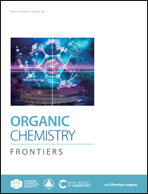C–H borylation: a tool for molecular diversification
Abstract
Iridium-catalyzed C–H activation and borylation has become as a powerful synthetic tool in the past few decades because of the widespread applicability and versatility of organoboron compounds. This reaction is currently receiving extensive research interest in both academia and pharmaceutical industries because of its ability to attain a high degree of molecular complexity from simple building blocks. This review aims to highlight the implementation of C–H activation and borylation strategies in tandem one-pot transformations for the synthesis of complex natural products, for the late-stage modifications of bio-active molecules and pharmaceuticals, and for the functionalization of aromatic polycyclic systems used in materials chemistry.

- This article is part of the themed collections: Organic Chemistry Frontiers 10th Anniversary Collection and 2024 Organic Chemistry Frontiers Review-type Articles


 Please wait while we load your content...
Please wait while we load your content...